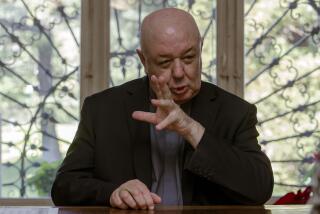Vatican treasures illuminate a 2,000-year-old legacy
- Share via
HOUSTON — Hundreds of priceless items from 2,000 years of the Roman Catholic papacy, many of them stored in Vatican collections and not normally seen even in Rome, went on display Sunday for the first time in the United States.
The exhibition, titled “St. Peter and the Vatican: The Legacy of the Popes,” made its debut at the Houston Museum of Natural Science and continues through July 27.
“If you came to the Vatican, two-thirds of these things you would never see because they are in storerooms or archives or sacristies that are never open to the public,” said Father Allen Duston, international director of the Office of the Patrons of the Arts in the Vatican Museums.
“So this is a very unique opportunity to see many of the things that are kept in the Vatican that have been there, in some cases, for nearly 2,000 years.”
Houston museum officials are anticipating that thousands of people from the South, the Southwest and Mexico will view the exhibition during its first stop on a four-city U.S. tour.
The items, including objects from as far back as the 4th and 5th centuries, focus on the Roman Catholic popes, beginning with the first, St. Peter, who was martyred in Rome in the year 67 by being crucified upside down, to John Paul II, the 265th pontiff.
John Paul II bookends the exhibition. A written message from the pope greets visitors at the entrance. A bronze cast of his right hand, with his signature engraved beneath it, is the last item visitors see.
In between, in chronological order, the exhibition tracks the early days of the church, through the Renaissance and into modern times.
“The church has influenced civilization for 2,000 years, and this will give you perhaps a closer relationship with part of that history,” Duston said.
Among the oldest items is a 5th century mosaic of St. Peter and a 4th century pin with a monogram of Jesus Christ.
One of the stranger pieces is a reliquary from Pope St. Pius V, who died in 1572. It’s a container that holds his finger, his ring still around it.
Duston, a Dominican priest who was recruited to the Vatican while teaching at UC Berkeley several years ago, said he believes the most significant piece displayed is the Mandylion of Edessa, a tempera-on-linen image from the 3rd to the 5th century that may be the earliest representation of the face of Christ.
There are papal crowns and vestments, sculptures and paintings and drawings, and religious tools such as precious metal chalices and monstrances, used in public displays for what Catholics believe to be the body of Christ.
Duston said one silver monstrance, from Genoa in 1750, was found in 2,200 pieces in a Vatican storage closet in a paper bag. It was cleaned and reassembled.
After deciding on a theme for the project, Vatican officials had to settle on items that could be safely moved halfway around the world.
Some paintings, for example, were too fragile and couldn’t be exposed to humidity. And although insured, the items simply can’t be replaced.
A 531-page catalog accompanies the show, which was put together by the exhibition division of media conglomerate Clear Channel Communications.
Other stops on the 18-month American tour, which has been at least four years in the making, are the Museum of Art in Fort Lauderdale, Fla.; the Cincinnati Museum Center; and the San Diego Museum of Art.
More to Read
Sign up for The Wild
We’ll help you find the best places to hike, bike and run, as well as the perfect silent spots for meditation and yoga.
You may occasionally receive promotional content from the Los Angeles Times.






